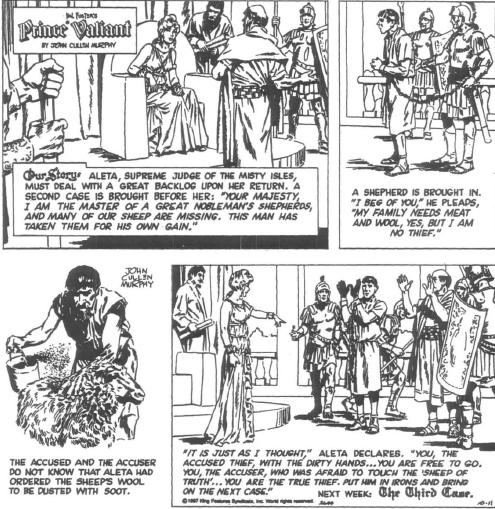“The Homemade Lie Detector”
I read the comic strips faithfully, and every so often I find an urban legend amid the funnies.
Take Hal Foster’s “Prince Valiant,” for instance, in the Sunday funnies for October 11, 1987. In that strip, Prince Valiant’s wife, Queen Aleta of the Misty Isles, drew on folklore to settle a dispute between two men who accused each other of stealing a sheep.
The beautiful and wise queen employed a device I call “The Homemade Lie Detector” and so tricked the thief into revealing his guilt.
She had herself blindfolded—“for justice must be blind”—and then had the sheep in question led into the room. She commanded each man to “grasp the wool on the sheep’s back,” saying that the sheep itself would identify the thief.
Then the queen removed her blindfold and immediately inspected each man’s hands. One man had dirty hands, and the other had perfectly clean ones.
Unbeknownst to them, she had ordered her minions to dust the sheep’s back fleece with soot.
The thief, fearing to be unmasked by the queen’s odd procedure, had been afraid to touch the sheep, as his soot-free hands proved. Clean hands meant guilt in this case.
The same trick has been attributed to John Napier (1550–1617), the Scottish mathematician who invented logarithms. According to Howard Eves, An Introduction to the History of Mathematics
(3d ed., 1969), one of many stories “probably unfounded” told about Napier was that he used a “homemade lie detector” to identify a servant who had stolen a rooster from him.
Napier supposedly declared that if each servant placed his hands on the coal-black rooster in a
darkened room, the rooster would identify the thief.
Lampblack that had been smeared on the bird’s back and rubbed off on the servant’s hands was the giveaway this time.
In another version, told in Europe, a cock is placed under a sooty cooking pot, and cock and pot are left in a darkened room. One by one the suspects are brought in.
printed with special permission of King Features Syndicate. Inc.
Supposedly the cock will crow when the thief touches the pot…. well, you know the rest.
I also have a folder full of international variations of the story. In a Chinese variation sent to me by Professor Nai-Tung Ting of Western Illinois University, a crafty judge places a bell smeared with India ink behind a curtain to detect thieves. Professor Ting believes that the story may go back as far as the Sung dynasty, which lasted from 960 A.D.
to 1279 A.D.
He also has found a
Tibetan variant in which a learned judge is unable to identify the guilty man, but a clever villager does it via the old smeared-bell trick.
Then there’s a Japanese legend about “Ooka the Wise,” who sends the suspects to place their hands into the mouth of a stone statue of a god in a roadside shrine. Hands clean of dust from the statue’s mouth reveal the thief.
In a Middle Eastern version I found in the May 1963 Reader’s Digest
, a nomad chieftain uses a donkey inside a tent as his lie detector. The animal’s tail is dipped in a solution containing mint, and the suspect who fails to pull the tail when he is sent into the tent with the donkey lacks the scent of mint upon his hands when the chieftan sniffs them later.
An Argentine version dispenses with the animals. Two suspects are each given “magic sticks” of equal length to keep overnight. The guilty man’s stick is supposed to grow longer while he sleeps.
In the morning, though, the man with the shorter stick is declared guilty. He has cut it himself, believing it would really grow and hoping to remain undetected. This seems similar to Pinocchio’s nose growing longer whenever he tells a lie.
The closest I can get to modern legends with this story is some instances of “The Homemade Lie Detector” as American rural
legends. For example, a version collected in the Ozarks in 1923 but remembered from the 1890s by the storyteller uses a “poppet” (a doll) smeared with walnut juice that stains the hands. A version from Beech Creek, North Carolina, published in 1956 has a preacher use the cock-under-the-pot trick to catch a thief.
The novelist Jack London must have heard this story, too, perhaps in Alaska. In his book Children of the Frost
(published in 1902), an Indian medicine man, is asked to determine who stole a woman’s blanket. So he sets a
black raven under a cooking pot—the age-old gimmick that never fails.
Does “The Homemade Lie Detector” have any currency as a truly modern legend? I don’t know. Perhaps its appearance in “Prince Valiant” was just the last echo of an old story. I also wonder whether the trick was ever actually used or if it’s merely a fictional story told to illustrate somebody’s cleverness and somebody else’s guilty conscience.
Obviously, I look for a lot more in the comics than your average Sunday-morning reader does. It’s tough work, but—no lie—somebody’s got to do it.


